The team working on Crested Auklets needed an extra hand today and asked if I'd be willing to help out. Of course, I jumped at the chance! Although Crested Auklets are fairly common breeders on St. Paul Island, the places on the island that I've been working have only offered somewhat distant views of these interesting birds.I met Thibaut Vergoz at the seabird house around 9:30 this morning and we took off in the Arctic Cat for Zapadni, fairly close to where the Least Auklet study site is located. The Crested Auklets nest much higher up on the cliff face than the Least Auklets, so we had a bit of a climb to get to the study site. Of course we're hauling all manner of sampling equipment, nets, poles, and our own gear over the steep rocky slope, hopping from rock to rock like mountain goats! I am getting more practiced at the technique, albeit with scraped knees and a nice tear in my waterproof overalls to show for it!

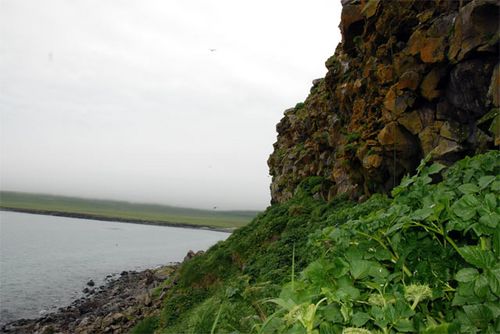
We had two important goals in mind. To capture some Crested Auklets and collect some blood samples that would be used to analyze stress hormone release, telomeres, DNA, and stable isotopes which will give the scientists a better sense of the diet and the trophic level (where the birds fit in the food chain) and potentially where the birds are feeding. All of this is blood work is quite fascinating and will be the subject of an upcoming journal entry.
The second goal was a bit more exciting. About a week ago, two of the auklets nesting on this cliff face had been outfitted with Time-Depth-Recorders or TDRs. This was the first time that such a data logger had EVER been deployed on a Crested Auklet. Catching one or both of these birds would be a major contribution to the understanding of the at-sea behavior of these birds. With the TDR we could begin to find out, how deep do the auklets dive and for how long? How much time do they spend away from their nest? The concern however, was that the logger birds had not been observed since the equipment was attached and it was quite possible that they had left the area with about a thousand dollars worth of technology taped to their feathers!
The logger birds were banded in a different manner than other Crested Auklets that had been caught previously and a small piece of white, waterproof tape had been attached to the back of the birds' heads to aid in the identification of these individuals from the hundreds of auklets that flew into and out of the cliff face. Once we arrived at the site where the logger birds were originally caught, we set up the mist net to see if that would work to capture some Crested Auklets. It wasn't long before we had our first customer. After carefully removing the bird from the net and placing it safely in a cloth bag. Thibaut took a small amount of blood from the alar vein of the birds, a vein just under the elbow on the underside of the wing of the bird. A small capillary tube, a thin glass cylinder is placed against the drop of blood and draws it up into the tube. The samples are placed into various collection vials, carefully labeled and place in a baggie and stored in a cooler.
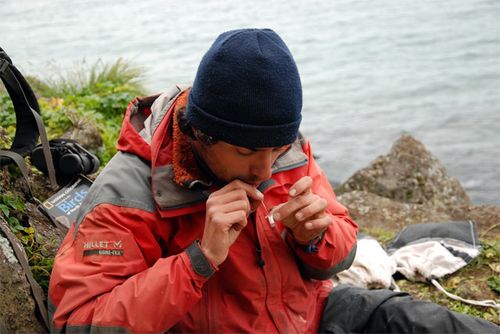
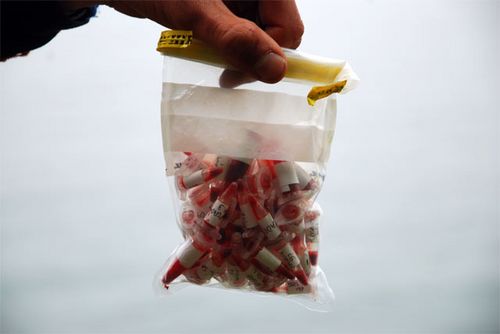
As the day progressed, we were extremely busy, either removing birds from the net, collecting blood, labeling vials, taking measurements of the birds, banding birds, recording data in a field notebook and other details of this work. We also hit the auklet trifecta, capturing all three of the species that nest on St. Paul Island, Crested, Least and Parakeet Auklets.
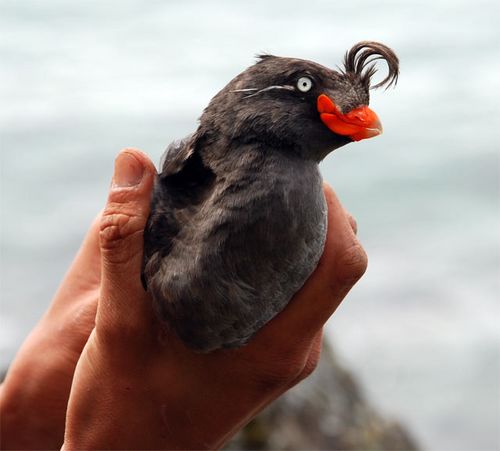
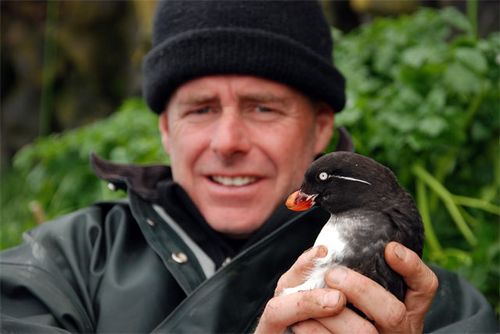
There really was never any down time at all. We'd started that morning about 9:30 in the morning and before we knew it, it was nearly 8:00 in the evening. Then it happened. A Crested Auklet flew into the net with a distinctive piece of white tape on the back of the head. One of the logger birds! As we carefully untangled the bird from the mist net, we were relieved to see that the TDR was still securely taped to the underside of the bird.
We removed the device and stored it in a glass vial for safe keeping. The information stored within the circuitry of that little glass capsule that we'd recovered would be the first time in history that that the depth and duration of dives of a Crested Auklet would be recorded!
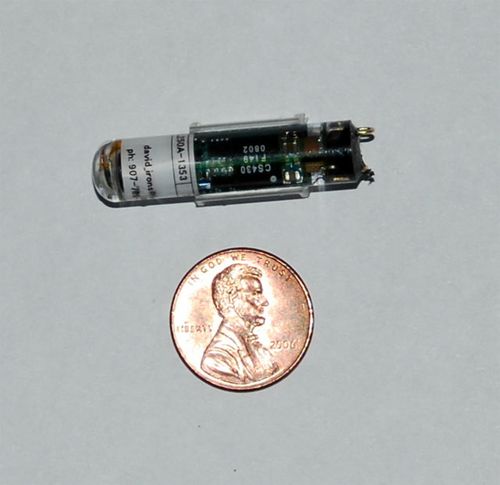
The data still needs to be downloaded and analyzed, but essentially, for a five day period since it was deployed, the little logger would record its depth and the time of day every two seconds. This will reveal how deep the bird dive in pursuit of the copepods and other zooplankton that make up their diet and how long they stay under water. It was pretty exciting to be a part of this historic logger recovery effort!
We continued to catch birds and we stayed on at our Crested Auklet site, with a renewed hope that the second logger bird might still be caught. Around 11:30 at night, as the daylight began to fade and hopes for capturing the second logger bird dimmed, we began to pack up the net. As we undid the poles and netting Ine and Allister (one of the fur seal team members) had arrived at the study site to check on us, since they didn't expect us to be out in the field so long. As the project leader, Ine was particularly excited to hear that we'd gotten the logger bird back and that the logger was recovered (and of course, that we were ok!).
It was quite an exciting day in the field and even more thrilling to be returning with that important data set that will help us learn more about the Crested Auklet!

Bird Species seen: Red-faced Cormorant, King Eider, Parakeet Auklet, Least Auklet, Crested Auklet, Tufted Puffin, Horned Puffin, Thick-billed Murre, Common Murre, Short-tailed Shearwater, Wandering Tattler, Rock Sandpiper, Ruddy Turnstone, Black-legged Kittiwake, Red-legged Kittiwake, Lapland Longspur, Winter Wren, Northern Raven, Gray-crowned Rosy Finch.
Mammals: Northern Fur Seal, Arctic Fox


Comments